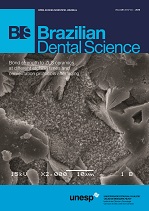CO2 laser for dental alumina ceramic framework welding
DOI:
https://doi.org/10.14295/bds.2019.v22i4.1797Abstract
Objective: Despite the increase of all-ceramic prosthesis in dental practice there is no evidence of the possibility of welding these structures if necessary. The objective of this study was to use CO2 laser (?=10.6µm) as a welding agent to fuse dental polycrystalline alumina ceramic. Methods: Ceramic blocks of pre-sintered alumina were sectioned into 20 bars (10.0 x 1.5 x 1.5mm) and sintered to the final cross?section dimension of 1.2 x 1.2mm. The bars were adapted to an LHPG (Laser Heated Pedestal Growth) system device where the bars could be fixed in pairs and have their ends irradiated with CO2 laser to fusion. The ring-shaped laser beam (300 µm thickness) was directed with the aid of mirrors to reach samples’ ends. The laser was continuously applied (40W nominal power, 5 seconds). After welding, the samples were analyzed in stereomicroscope and SEM. A diffraction analysis was carried out with one sample. Results: The ceramic bars were successfully fused, but some of them showed some shape distortion in the fusion zone. The aspect of the fused alumina differed in color and translucency from the original sintered material. SEM evidenced the presence of porosity and voids in the center of the fusion zone. X-ray diffraction pointed to a reduction in crystallite size by two to four times in the welded region of samples. Conclusions: This study points to CO2 laser as a possible welding agent to polycrystalline alumina dental ceramic. Porosity observed in the molten zone gives cause for concern regarding weld resistance.
Downloads
Downloads
Published
How to Cite
Issue
Section
License
Brazilian Dental Science uses the Creative Commons (CC-BY 4.0) license, thus preserving the integrity of articles in an open access environment. The journal allows the author to retain publishing rights without restrictions.
=================




























